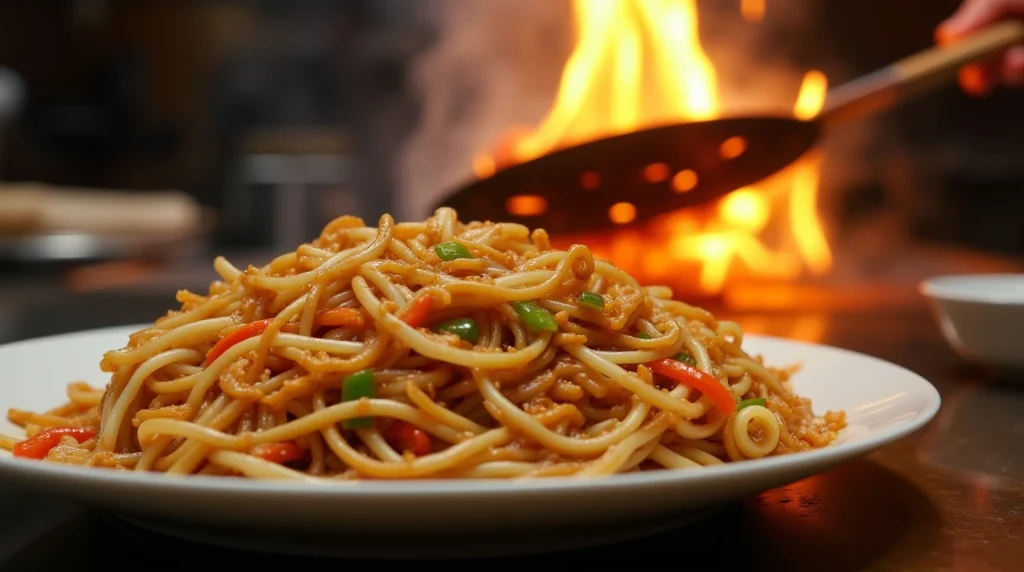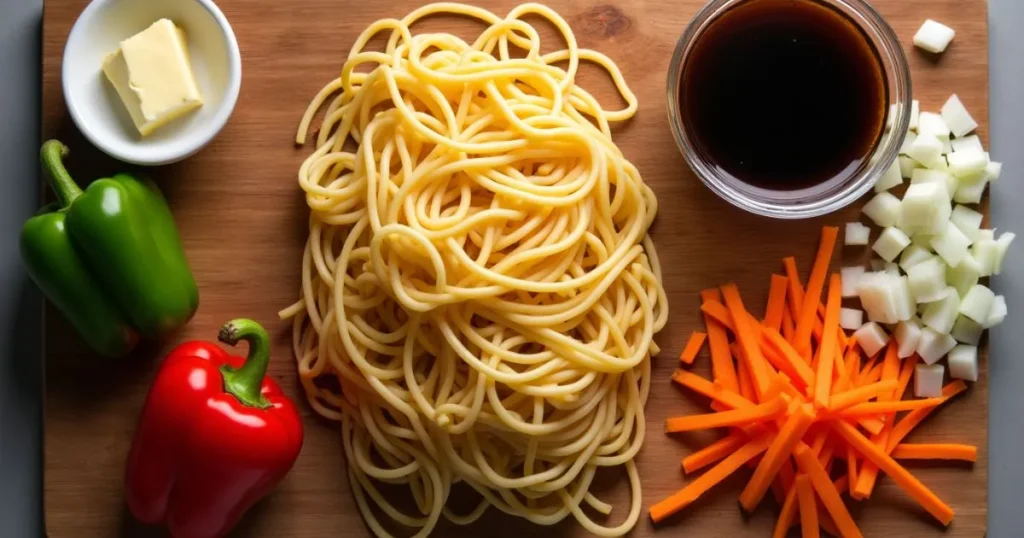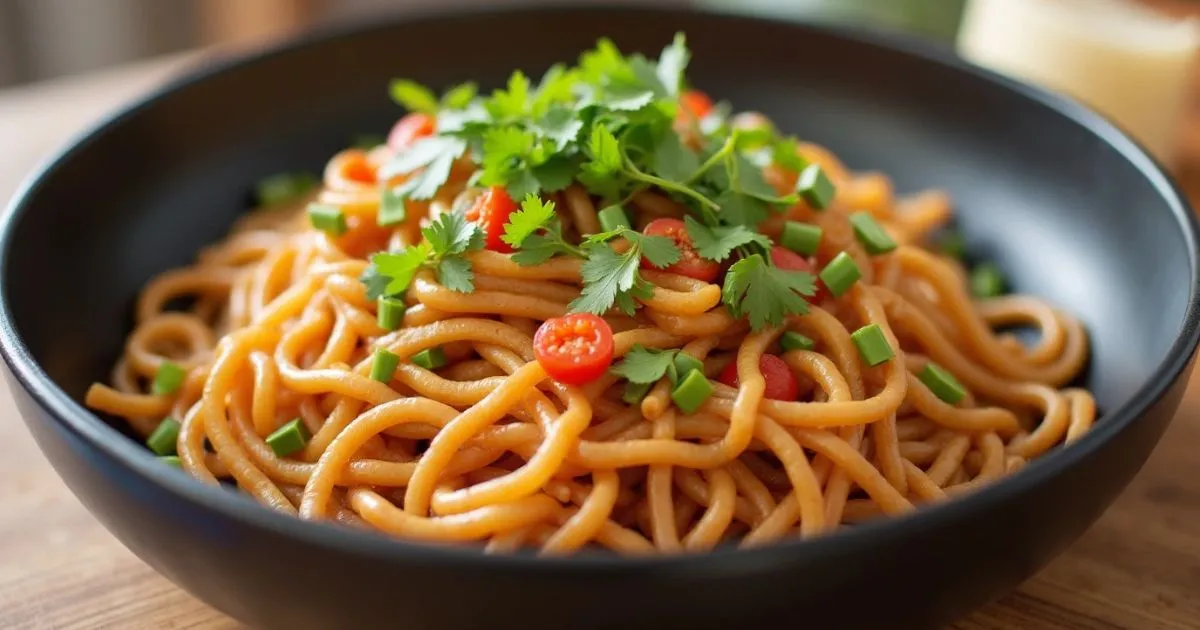Easy Hibachi Noodle Recipe (Quick & Delicious!) – Learn how to cook flavorful hibachi noodles
Do you love the sizzling hibachi noodle Recipe from your favorite restaurant? You can make them at home with just a few simple ingredients. No fancy equipment needed—just soy sauce, butter, and pantry staples. These savory noodles have a buttery, slightly sweet flavor that’s perfect for Asian-inspired dishes.
Table of Contents
This guide will teach you how to cook hibachi noodles step by step. You’ll learn how to mix tangy, salty, and umami flavors in under 30 minutes. Whether you use a skillet or griddle, you’ll get restaurant-quality noodles every time.
Key Takeaways
- Make hibachi noodles with everyday ingredients like soy sauce, butter, and sesame oil.
- Ready in 20-30 minutes—no complicated techniques required.
- Adjust sweetness or heat to match your taste preferences.
- Pair with proteins like chicken or veggies for a full meal.
- Reuse the sauce recipe for other dishes like stir-fries.
What Are Hibachi Noodles?

Hibachi noodles come from Japanese cooking traditions and are loved in American homes. They are stir-fried with veggies, proteins, and tasty sauces. This mix creates bold flavors in each bite. Let’s explore their history and what makes them special.
The History of Hibachi Cooking
At first, “hibachi” meant small charcoal heaters in Japan. Later, it became known for outdoor grilling. American restaurants made it famous with the open-flame cooking we see today. Teppanyaki, on the other hand, uses flat iron griddles, making its own teppanyaki noodles version.
Difference Between Hibachi and Teppanyaki
| Aspect | Hibachi | Teppanyaki |
|---|---|---|
| Grilling Surface | Charcoal grill with open flames | Flat iron plate |
| Origin | Traditional Japanese outdoor cooking | Modern Japanese dining style |
| Signature Dishes | Skewered meats, hibachi noodles | Sizzling pancakes, teppanyaki noodles |
Why Hibachi Noodles Are So Popular
- Entertainment factor: Watching chefs flip ingredients is fun.
- Customizable: You can pick your favorite veggies, meats, or sauces.
- Quick & tasty: They cook fast with bold soy-based flavors.
Now you know their history, let’s learn how to make these dishes unforgettable at home.
Essential Ingredients for Authentic Hibachi Noodles
To make the perfect hibachi noodle recipe, start with the right ingredients. Each one adds flavor and texture to your dish. Here’s what you need:
- Yakisoba noodles (or linguine as a substitute): These thin, wheat-based noodles are the star of the hibachi noodle recipe.
- Unsalted butter: Adds richness and helps caramelize ingredients on the griddle.
- Japanese soy sauce: Choose Kikkoman or Marukome for the umami foundation.
- Sesame oil: A drizzle enhances the nutty aroma essential to the dish.
- Minced garlic and grated ginger: These aromatics form the flavor base.
- Veggies like bell peppers, onions, and carrots: Sliced thinly for even cooking.
“The right ingredients make all the difference. Never skimp on soy sauce quality—it’s the soul of hibachi.” — Chef Hiroshi Tanaka
Look for linguine at grocery stores if yakisoba isn’t available. For soy sauce, avoid low-sodium brands to maintain balance. Sesame oil should be pure, not blended with other oils. Garlic and ginger must be fresh for maximum punch.
Pair ingredients like scallions or bean sprouts for freshness. Sauce ingredients (soy sauce, mirin, sugar) should be measured precisely. Adjust seasonings to taste but stick to ratios in the hibachi noodle recipe for best results.
Equipment Needed for the Perfect Hibachi Noodle Experience
Mastering hibachi noodles begins with the right tools. The Blackstone griddle is the best choice for its large flat surface and high heat. It’s perfect for cooking hibachi noodles on blackstone. You can sear proteins, sauté veggies, and cook noodles all at once.
If you don’t have a Blackstone, cast-iron skillets or electric griddles are good alternatives. Tools like spatulas and squeeze bottles are also important for achieving that restaurant flair.
Using a Blackstone Griddle
The Blackstone griddle’s broad cooking area is ideal for hibachi noodles on blackstone. Heat it to 600°F for that signature char. Clean the surface with a brush and oil before cooking.
Preheat to medium-high to keep noodles and proteins crispy. Its nonstick coating prevents sticking, ensuring even cooking. Pro tip: Use a bench scraper to manage ingredients while flipping and tossing.
Alternative Cooking Surfaces
No Blackstone? Cast-iron skillets or electric griddles can substitute. Woks work for stir-frying, but may lack space. Use a large skillet if needed.
Adjust heat settings to match the Blackstone’s intensity. A flat, smooth surface is key for flipping ingredients efficiently.
Must-Have Utensils
- Long-handled spatula: For flipping meat and veggies without burning hands.
- Bench scraper: Keeps ingredients organized on the griddle.
- Squeeze bottles: Perfect for drizzling sauce evenly.
- Tongs or chopsticks: Toss noodles and mix ingredients without overcrowding the pan.
Combine these tools to recreate the sizzling, showstopping dish at home. Every utensil plays a role in achieving that authentic hibachi noodles on blackstone experience.
Preparing Your Ingredients for Hibachi Noodles
Mastering the hibachi noodle recipe begins with careful ingredient prep. Professional chefs use mise en place to manage the dish’s quick cooking. Here’s how to get perfect results:
- Noodles: Boil spaghetti or ramen until it’s just right, then rinse in cold water. Toss with oil to stop clumping.
- Vegetables: Cut bell peppers, onions, and mushrooms into ¼-inch strips. Make sure all veggie pieces are the same length for even cooking.
- Proteins: Marinate chicken or shrimp in soy sauce and sesame oil for 30 minutes. Pat dry before cooking.
- Sauces: Mix teriyaki, rice vinegar, and sriracha in a bowl. Keep it separate until you’re ready to add it.
Save time by chopping veggies the night before and storing them in airtight containers. Marinate proteins while you heat up your griddle. This way, everything cooks evenly during the high-heat process.
Skipping this step can lead to uneven seasoning or burnt edges. These are common mistakes in the hibachi noodle recipe. Keep all your prepped ingredients within reach to keep your workflow smooth. This turns kitchen chaos into a professional-grade meal.
The Ultimate Hibachi Noodle Recipe
Learn to make the perfect hibachi noodle recipe with this easy guide. Each step is designed to bring out the lively flavors of hibachi noodles found in restaurants. Let’s get started:
Ingredient Measurements and Preparation

- 8 oz yakisoba noodles (boiled 6-8 mins, drained)
- 2 tbsp butter (divided for cooking surface)
- 2 tbsp soy sauce + 1 tbsp mirin (for the base sauce)
- 1 cup mixed veggies (bell peppers, onions, carrots, sliced thin)
Sauce Preparation
Mix 3 tbsp soy sauce, 2 tbsp rice vinegar, 1 tsp grated ginger, and 1 minced garlic clove. Heat it until it thickens. This is your hibachi noodles sauce base. Add 1 tsp sugar if you want it sweeter.
Cooking Process Step-by-Step
- Heat a dry griddle to 400°F. Add 1 tbsp butter, swirling to coat.
- Sauté veggies 3-4 mins until crisp-tender. Push to side.
- Add remaining butter. Toss in noodles and 1 tbsp soy sauce. Combine with veggies.
- Pour sauce over noodles. Stir vigorously for 2-3 mins until glossy and slightly charred.
- Season with sesame oil and green onions before serving.
Cook everything at once to keep it hot. Serve right away for the best taste.
Mastering the Hibachi Cooking Technique
Turn your teppanyaki noodles into a show with these key techniques. Learning to control heat, motion, and flair makes meals unforgettable.
Temperature Control Tips
Split your griddle into different zones. Use the center for high heat to sear proteins. The edges are for medium heat to cook teppanyaki noodles.
Oil should shimmer but not smoke, which means it’s at the perfect temperature. Move ingredients around to prevent burning. Look for oil bubbles to know when it’s ready.
Proper Stirring and Flipping Methods
- Stir noodles gently with a flat spatula to avoid clumping.
- Flip ingredients swiftly using a flick of the wrist for even cooking.
- Rotate ingredients between hot and cooler zones as they cook.
Adding Showmanship to Your Cooking
Make your cooking a show! Create an onion volcano by tossing thinly sliced onions high up. Flip eggs with precision or juggle tongs for flair.
Match your moves with the cooking steps. This way, you entertain while keeping your teppanyaki noodles delicious.
How to Cook Hibachi Noodles on a Blackstone Griddle
Learn to cook hibachi noodles on blackstone with these tips. First, heat your Blackstone griddle to 400°F. Use oil and a paper towel to wipe the surface. This step prevents smoke and ensures even cooking.
- Divide the griddle into zones: one for noodles, one for proteins, and one for vegetables. Leave space between zones to avoid overcrowding.
- Add noodles first, stirring constantly. Cook until slightly charred for authentic texture.
- Season as you go, using tongs to flip ingredients. Use a spatula to manage smaller items like veggies.
| Blackstone Model | Optimal Temperature |
|---|---|
| 18″ Griddle | 375–400°F |
| 36″ Griddle | 400–425°F |
Wind can disrupt heat control outdoors. Shield your griddle with a barrier if needed. After cooking, turn off heat and let it cool slightly before wiping with a cloth. Never submerge the griddle in water to protect its coating.
For the full experience, serve directly from the Blackstone. Guests love watching the sizzling dish. Clean with mild soap and warm water, then re-season lightly with oil.
Pairing Proteins with Your Hibachi Noodles
Make your hibachi meal better by adding proteins that sizzle and please your taste buds. These choices fit different diets and keep the bold flavors you love.
Hibachi Chicken Recipe with Noodles
Begin with hibachi chicken recipe with noodles for a timeless mix. Marinate chicken strips in soy sauce, minced ginger, garlic, and a bit of sugar for 30 minutes. Cook it over high heat until it’s golden, then mix it with your favorite noodles and sauce. Tip: Cut chicken into 1-inch pieces for even searing.
- Marinade: ¼ cup soy sauce, 1 tbsp grated ginger, 2 minced garlic cloves, 1 tsp sugar
- Method: Sear chicken first, then add cooked noodles and sauce mixture
Seafood Variations
Try shrimp, scallops, or mixed seafood. Cook seafood separately to avoid overcooking—aim for 2-3 minutes per side. Toss with noodles at the end to keep them tender.
| Seafood | Cooking Time | Seasoning |
|---|---|---|
| Shrimp | 2-3 mins/side | Lemon juice + sesame oil |
| Scallops | 2 mins per side | Black pepper + chili flakes |
Vegetarian and Vegan Options
Use firm tofu, tempeh, or seitan. Marinate tofu in soy sauce, lime juice, and smoked paprika for 15 minutes. Pan-fry until crispy, then mix with noodles. Swap butter for coconut oil to make it vegan.
Pro tip: Add mushrooms and bell peppers for umami depth.
Classic Hibachi Vegetable Combinations
Classic hibachi noodles are best with vegetables that mix flavors and textures. Onions, zucchini, mushrooms, and bean sprouts are key. They cook fast and soak up savory sauces well.
Thinly sliced onions start by caramelizing, adding sweetness. Zucchini, cut into ¼-inch half-moons, stays crisp. Mushrooms, sliced thickly, bring out umami. Bean sprouts add crunch when added last.
- Onions: Slice ⅛-inch thick
- Zucchini: Quarter-moon cuts for even browning
- Mushrooms: ½-inch slices
- Bean sprouts: Add raw in the final 2 minutes
Cook in this order: onions → zucchini → mushrooms → bean sprouts. This keeps delicate veggies from getting overcooked.
Try adding more veggies to your dish:
- Bell peppers (julienned strips)
- Cabbage (thin wedges)
- Bok choy (stem and leaves separated)
| Season | Vegetables |
|---|---|
| Spring | Asparagus, snap peas |
| Summer | Corn kernels, cherry tomatoes |
| Fall | Caramelized carrots, Brussels sprout halves |
| Winter | Butternut squash cubes, leeks |
Choose veggies that complement the noodles without overpowering them. Adjust cooking times for thicker cuts. These combinations keep hibachi noodles exciting all year.
Signature Hibachi Sauce Recipes
Take your hibachi noodle recipe to the next level with these bold, flavorful sauces. Each blend is crafted to complement the smoky heat of grilled ingredients. Follow these easy steps for homemade perfection.
Yum Yum Sauce
- Mayonnaise (1/2 cup)
- Ketchup (3 tbsp)
- Rice vinegar (2 tbsp)
- Sugar (1 tsp)
- Paprika (1/2 tsp)
- Garlic powder (1/4 tsp)
Whisk all ingredients in a bowl. Let rest for 15 minutes before serving. Add sriracha for a spicy kick. Stores refrigerated up to 1 week.
Ginger Sauce
Grate 2 tbsp fresh ginger into a blender. Blend with:
- Soy sauce (1/4 cup)
- Rice vinegar (2 tbsp)
- Lemon juice (1 tbsp)
- Minced onion (1 tbsp)
Strain mixture through a sieve for smooth texture. Drizzle over chicken or shrimp hibachi noodle dishes.
Teriyaki Glaze
In a saucepan, combine:
- mirin (1/4 cup)
- soy sauce (1/4 cup)
- mirin (2 tbsp)
- sesame oil (1 tsp)
Simmer until thickened. Brush onto proteins while cooking for caramelized edges. Keeps refrigerated for 2 weeks in a sealed container.
Common Mistakes to Avoid When Making Hibachi Noodles
Mastering hibachi noodles or teppanyaki noodles needs careful attention. Steer clear of these common errors for perfect results every time.
Don’t overcrowd the griddle. Overlapping ingredients steam instead of sear, losing that crispy texture. Cook in batches if necessary. Wet noodles sticking? Drain them well after boiling to prevent browning.
Heat control is crucial. Low heat makes noodles soggy, while high heat can burn them. Always preheat your griddle to medium-high.
- Wrong ingredient order: Add proteins first, then veggies, then noodles last for even cooking.
- Under-seasoning: Taste and adjust sauces mid-cook to balance umami flavors.
| Problem | Cause | Solution |
|---|---|---|
| Sticky noodles | Wet noodles or overcrowding | Pat noodles dry; spread evenly on griddle |
| Burnt edges | Too-high heat | Lower heat to medium-high and stir frequently |
| Bland flavor | Untested seasoning | Taste sauce and adjust with soy sauce or sriracha |
Prevent mistakes by prepping ingredients first. Use tongs to toss noodles and keep sauces ready. These tips ensure your homemade teppanyaki noodles are as good as restaurant versions every time.
Presentation Tips for Restaurant-Quality Hibachi Noodles
Make your hibachi chicken recipe with noodles look like it came from a restaurant. Follow these expert tips. Every little thing, from the plate to the setting, makes a difference.
Plating Techniques
- Warm plates in white or dark colors to highlight your food.
- Heap noodles a bit to add height, then put chicken in the middle.
- Circle your sauce for a neat look.
Garnish Ideas
Enhance your dish with these creative garnishes:
- Green Onion Curls: Roll green onions thinly and arrange in a spiral.
- Sesame Seeds: Sprinkle them around the plate’s edge.
- Microgreens: Place a light layer under noodles for freshness.
- Edible Flowers: Add one or two for color.
Creating a Complete Hibachi Experience
Transform your kitchen into a hibachi show with this plan:
| Step | Time/Details |
|---|---|
| Setup | 15 mins – Set out chopsticks, soy sauce, and hibachi chicken recipe with noodles platters. |
| Cooking | Do a “show” for guests, flipping food. |
| Serving | Bring dishes to the table with a flair (if safe). |
| Dessert | Offer matcha ice cream with sesame dust. |
Play Japanese music and dim the lights to feel like a hibachi place. Serve family-style for everyone to share.
Storage and Reheating Tips for Leftover Hibachi Noodles
Make your hibachi noodles last for days without losing flavor. Storing them right keeps your dish fresh and safe. Cool leftovers down to room temperature first. Then, put them in shallow containers.
- Refrigerate within 2 hours. Store in airtight containers for up to 3-4 days.
- Reheat in a skillet with a splash of soy sauce or broth to restore moisture.
- For crispy edges, toast noodles briefly in a dry pan before adding sauce.
Reheating options vary:
- Stovetop: Cook in a lightly oiled skillet, stirring often.
- Microwave: Use 30-second intervals on medium power, covered in a microwave-safe dish.
- Oven: Bake at 350°F for 10-15 minutes for larger portions.
Bring back flavors by adding fresh garnishes like scallions or sesame seeds. Freezing is okay if needed, but texture might change after thawing. Always check for safe internal temps when reheating meats.
Conclusion
Now you know how to make hibachi noodles and chicken with noodles. It’s time to enjoy what you’ve made. These dishes are all about cooking fast, using tasty sauces, and bold flavors.
Try using different proteins like shrimp or tofu for a veggie option. You can also change up the veggies like bell peppers, onions, and mushrooms. Even leftovers can be great if you reheat them right.
Cooking at home means you can add your own touches and save money. Share your dishes on social media with #HibachiAtHome. Tag us to inspire others. Whether it’s for a party or just for you, you can make your kitchen a place of wonder.
Keep practicing your stir-fry skills and perfecting your sauce. Let your creativity shine. Every dish you make tells a story. Make yours one to remember.
FAQ
What are hibachi noodles?
Hibachi noodles are stir-fried noodles, often made with yakisoba. They include vegetables and proteins, cooked with a mix of sauces. This gives them a savory, slightly sweet taste, just like the real hibachi experience.
How do I cook hibachi noodles using a Blackstone griddle?
To cook hibachi noodles on a Blackstone griddle, first heat it up to high. Use a well-seasoned surface. Cook proteins, vegetables, and noodles in separate zones for the best texture and flavor. Stir often to cook evenly.
What ingredients do I need for a hibachi chicken recipe with noodles?
For hibachi chicken with noodles, you’ll need chicken breast, yakisoba noodles, and soy sauce. Add garlic, ginger, butter, and vegetables like bell peppers and onions. Sesame oil can also add extra flavor.
How can I make authentic teppanyaki noodles at home?
To make real teppanyaki noodles, cook on high heat with a flat surface like a griddle. Use the right noodles, like yakisoba or udon. Add soy sauce, garlic, and sesame oil for flavor. Good planning is key for quick cooking.
Can I make vegan hibachi noodles?
Yes, for vegan hibachi noodles, use tofu or tempeh instead of chicken. Replace butter with vegetable broth and add fresh vegetables. Soy sauce, garlic, and ginger will still give great flavor.
What sauces pair well with hibachi noodles?
Yum Yum sauce, ginger sauce, and teriyaki glaze are great with hibachi noodles. These sauces add richness and flavor, making them perfect for drizzling or dipping.
What are some common mistakes to avoid when making hibachi noodles?
Avoid overcrowding the cooking surface to prevent steaming instead of searing. Use dry noodles to avoid stickiness. Don’t forget to prep ingredients ahead of time. Good preparation and cooking are key for the best results.
How do I store and reheat leftover hibachi noodles?
Cool leftover hibachi noodles before storing them in shallow containers. Refrigerate for up to 3-4 days. To reheat, use a stovetop skillet or microwave. This helps restore flavors and textures.
Leave a Review & Rate This Recipe!
There are no reviews yet. Be the first one to write one.

